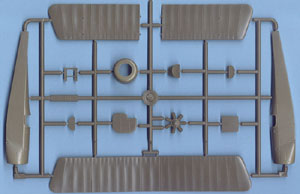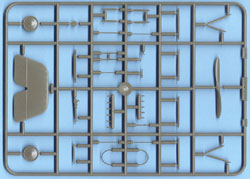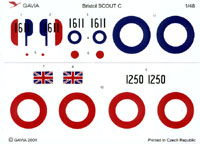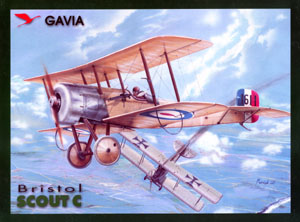Gavia's 1/48 Bristol Scout C | | History The Bristol Scout was an attractive fighter that had the distinction of being the mount of the first Victoria Cross winner for air-to-air combat, Captain Lanoe George Hawker. Performing admirably in both the Royal Flying Corps and the Royal Naval Air Service, the Scout remained in service for a long time, flying with training schools once it was outclassed in the skies over France. Built before synchronized machine guns were available, the Scout also had a wide variety of armament mountings, resulting in a large variation of appearances, accented by the two differently sized stabilizers and three differently sized rudders. Even with these differences, the look of the Bristol Scout is unmistakable and easily ranks up there with the most attractive World War One fighters.  The Kit The Kit
In a word, this kit is superb. In fact, the only real complaint I have is with the color of the plastic (if that's really a complaint). It's this weird greenish brown shade, but it will take paint just like any other plastic. The molding of this kit is incredibly crisp; easily rivaling anything I've seen from mainstream manufacturers. There aren't a lot of parts included, but that doesn't mean the kit isn't detailed. The interior is made up of seven parts, with the fuselage sidewalls having crisp detailing molded in. The engine is also nicely done, although once surrounded by that tight fitting cowling not much will be seen. Speaking of which, you'll probably want to thin down the visible edge of the cowling on the bottom.  The flying surfaces are the best I've seen and should be used by other manufacturers as a guide of what to shoot for in fabric-covered wings and tailplanes. This kit has the parts for a late Scout C with the larger stabilizer. Unfortunately the markings included in the kit are for planes with the earlier short-span stabilizer, but this shouldn't be too hard to make from the kit part. If you don't want to mess with the kit, though, there are plenty of interesting choices that can be found in the Datafile. The kit also includes separate control horns that will be fun to add, as there's nothing more than an outline showing where they go. The struts are thin and have the proper taper at the ends, and assembly will be a bit of a challenge to get all the struts aligned right. The flying surfaces are the best I've seen and should be used by other manufacturers as a guide of what to shoot for in fabric-covered wings and tailplanes. This kit has the parts for a late Scout C with the larger stabilizer. Unfortunately the markings included in the kit are for planes with the earlier short-span stabilizer, but this shouldn't be too hard to make from the kit part. If you don't want to mess with the kit, though, there are plenty of interesting choices that can be found in the Datafile. The kit also includes separate control horns that will be fun to add, as there's nothing more than an outline showing where they go. The struts are thin and have the proper taper at the ends, and assembly will be a bit of a challenge to get all the struts aligned right.
 Included in the instructions are drawings showing the basic arrangement of the rigging, which will add a lot to the appearance of the finished model. The decals have that slight problem mentioned earlier, but other than that are excellent, providing two choices. The first is for 1250 of the RNAS, November 1915. This plane has the red and white roundels on the wings and the Union Jack on the fuselage sides. The second example, of course, is that of Captain Hawker. This example has the red centers separate from the roundels, which is a nice touch. There's also two sets of numbers for the rudder, one with rudder stripes and one without, giving you the option to paint your own stripes. The decals are in excellent register as well as thin and should go down without any trouble. Included in the instructions are drawings showing the basic arrangement of the rigging, which will add a lot to the appearance of the finished model. The decals have that slight problem mentioned earlier, but other than that are excellent, providing two choices. The first is for 1250 of the RNAS, November 1915. This plane has the red and white roundels on the wings and the Union Jack on the fuselage sides. The second example, of course, is that of Captain Hawker. This example has the red centers separate from the roundels, which is a nice touch. There's also two sets of numbers for the rudder, one with rudder stripes and one without, giving you the option to paint your own stripes. The decals are in excellent register as well as thin and should go down without any trouble.
Conclusion If you want to build a Scout in 1/48, this is the kit to get. Even if you don't want to build a Scout in 1/48, you still need to get this kit. It's a great kit for a first-time WWI modeler, so if you're thinking of trying your hand at building a biplane, this will be a perfect kit for you. Available from Roll Models for only $26.25 | 

 




|
